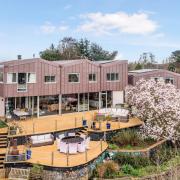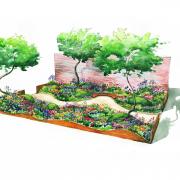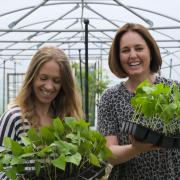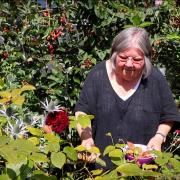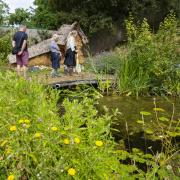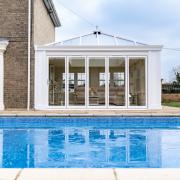Spring is in full swing and, with it, allotments are a hive of activity as enthusiastic gardeners eagerly sow and grow. It's no secret that growing your own food is good for the body and soul. It relaxes the mind, works your muscles and feeds your stomach with homegrown produce.
But with long waiting lists for allotments, uncertainty about the future development of land, and local councils with reduced budgets struggling to sustain these precious plots, this isn’t always an option for growers. So, if you want to grow a season’s worth of veg, maybe it’s time to think a little closer to home and create your own kitchen garden.
A kitchen garden is often dictated by the size of the overall garden and how much you’re prepared to etch out for growing veg. However, big is not necessarily better. For example, you don’t want a kitchen garden the size of a football field only to realise later that it’s too big to look after. Whether you opt for an open plot or raised beds, it should be an area you can happily cope with and access all areas for maintaining, watering and harvesting.

Weather is a key factor to growing your own; anything you attempt to grow will require sun, protection and nutrition. Therefore, think about how much sunshine your potential growing area will get, where the sun rises and sets, and where shadows linger. Some veggies require a good eight hours of sunshine, other crops, like lettuce, welcome a little shade to prevent them from bolting during the warmer season.
But before you can sow your first seed, consideration has to be given to the soil. If it’s an open plot, what’s the soil type? Heavy, light, acidic? This can affect what you’re trying to grow, so it’s worth investing in an inexpensive soil test kit. With raised beds, you control what goes into them. However, as these need filling, this can add to budget costs.
A vital requirement for any growing area is a water source. Plan your kitchen garden too far from the garden tap and you’ll be giving those arms a heavy workout as you drag watering cans up and down the garden throughout the growing season. Installing water butts in and around your growing area will make it better for you, your wallet and the environment.

Gardening books, magazines, garden shows and social media are great places to find inspiration. So, once ideas starting forming write them down. It doesn’t matter how far-fetched they seem at the time; you will whittle them down to what works best for your growing area.
A sketch of how you want your kitchen garden to look can really help you visualise the space. It doesn’t have to be complicated, just a simple bird’s eye view of beds, paths and structures. If you have the space and budget, a greenhouse, shed and compost bays are worthy additions.

If drawing’s not your thing, physically mark out your kitchen garden with pegs, string and rope. You don’t have to have it down to the exact centimetre, but it can give your plan substance. For example, are you going to be using a wheelbarrow? If so, push it around your marked paths to see if it works within the allocated area.
As the plan begins to take shape, consider what materials you’ll be using to build your garden – metal, wood, or something that’s been upcycled? You don’t need to spend a fortune. Ask an allotment holder; most are experts in recycling and re-using what’s available to them.
The reality for most of us is that garden space is limited, and with little room to grow, what are the options? Growing vegetables in flower beds alongside flowers is a great solution. Get the combination right between plant and vegetable, and these opposites will work together as they attract pollinators and deter pests.

Containers, pots and hanging baskets save on space and can make an attractive feature in the garden; for example, strawberries overhanging in baskets, or several varieties of lettuce displayed in a window box on a balcony. Potatoes will happily grow in sacks in a sunny, warm spot, taking up little room. Bear in mind though, containers can dry out quickly and exhaust soil nutrients. Therefore, ensure pots are regularly watered and apply a feed if necessary.
If space is an issue, try opting for quick turn around and dwarf variety vegetables. They take up less room and enable you to grow more. Long season crops, such as parsnips and leeks, will take up valuable space for most of the growing season. Sow successionally and harvest as soon as the veg is ready.
And if you can’t grow out, grow up. Canes and supports are ideal for growing beans and trailing squash. If it’s a balcony, try growing trailing crops, such as Tumbling Tom tomatoes, in hanging baskets or window boxes that let the plant trail over the balcony.
What can start as an unloved, unused, undervalued piece of land, can hold so much potential, as we mould, shape and create our very own Garden of Eden.

GARDEN JOBS FOR APRIL
Deadhead daffodils as they fade. This ensures the plant’s energy is transferred to the bulb for next year’s flora display. Let the foliage dieback naturally; it will harness the sun’s energy fuelling the plant for next season.
Climbing roses, clematis and honeysuckle will be putting on growth – ensure they are tied-in regularly as there’s still potential for a late frost and high winds.
Sow salads, radishes, beetroot, chard, kohl rabi, carrots and parsnips. Sow little and often to avoid a glut in a few months’ time. If the ground is still too cold, sow into seed tray modules. Water, label and place in a greenhouse or on a sunny windowsill. Young seedlings can be planted out when the soil is warm enough.

Towards the end of April, sow members of the cucurbit family. Pumpkins, squashes, marrows, cucumbers and courgettes can all be sown indoors. Runner beans, French beans and sweet corn can also be sown.
Lawns – mow regularly with the blades set at a low level for a clean, sharp cut. Scarify and fork over thatched areas to help with drainage. For bare patches, direct sow with grass seed, or replace area with fresh turf. Use an edging tool to keep borders tidy.










